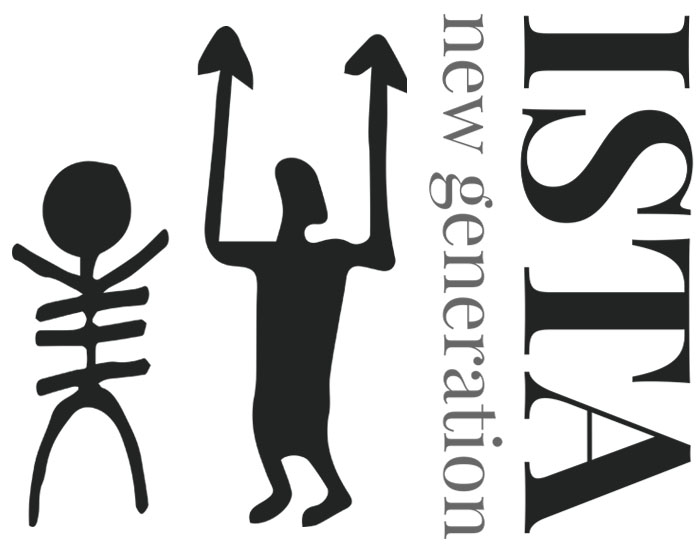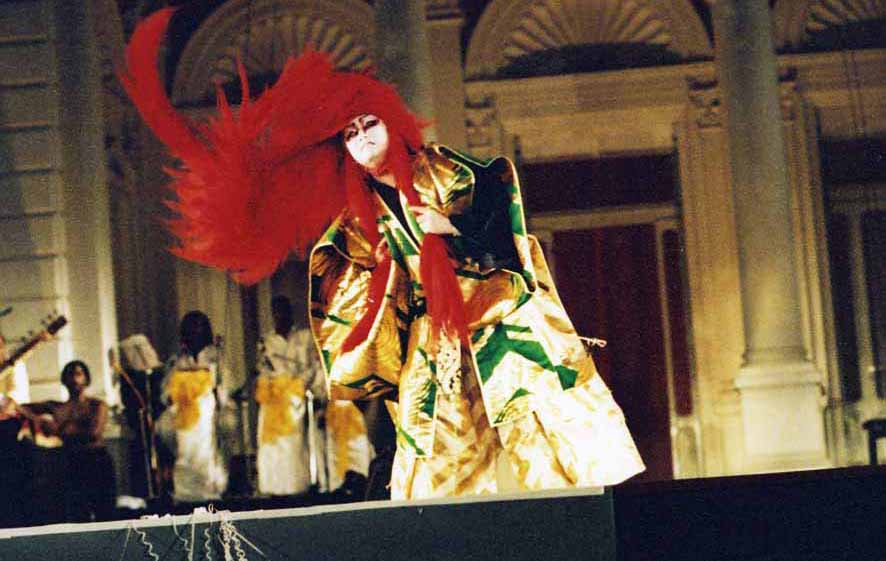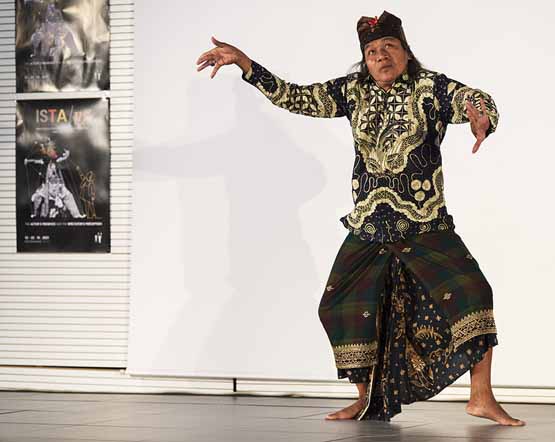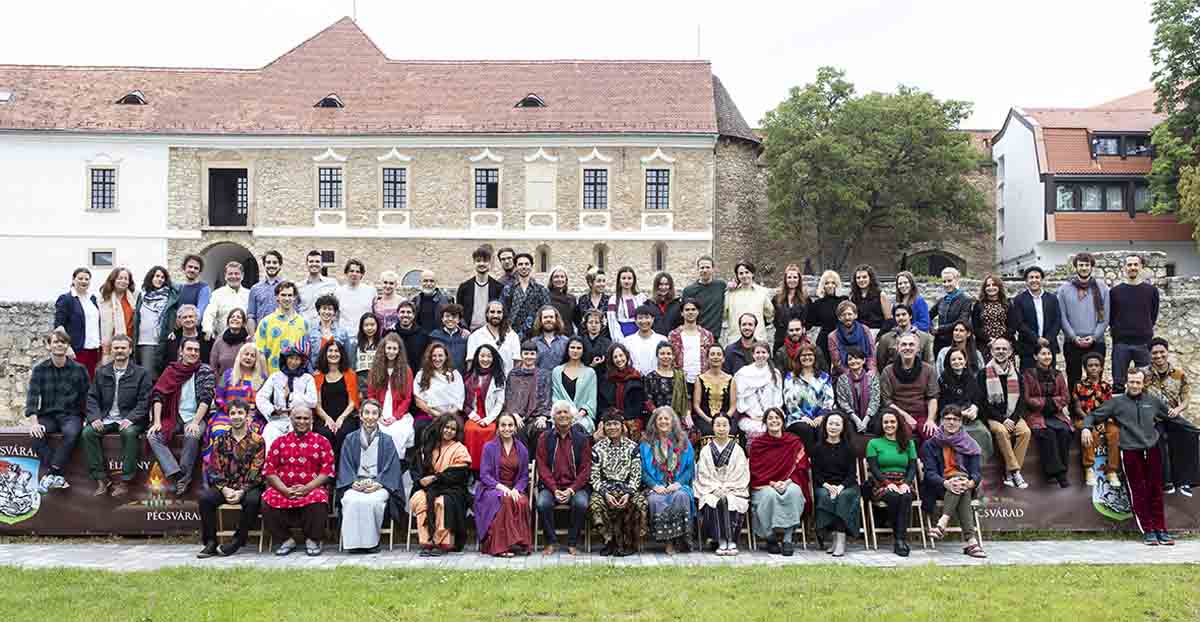SEGUICI:

La Fondazione Barba Varley promoted the birth of ISTA/NG, International School of Theatre Anthropology – New Generation.
Conceived and directed by Eugenio Barba, this training and research project aims to share and transmit theatre knowledge.
It involves a new generation of theatre/dance artists from different cultures and integrates teaching methods with new digital technologies.
ISTA/NG is a new addition to Eugenio Barba’s forty-year training and research activity on theatre anthropology by Eugenio Barba, director of ’Odin Teatret, is considered one of the masters and reformers of the 20th century theatre.
Since 1979, Barba has started an innovative field of studies on the common technical principles that underlie and guide the stage presence of actors and dancers in all cultures, and which he defines as “Theatre Anthropology”.


The following year he created ISTA – International School of Theatre Anthropology, an itinerant international laboratory of comparative studies on the principles of the actor/dancer’s technique.
Its team of scholars, experts from various disciplines and theatre/dance artists from various cultures, carries out research activities all over the world.
ISTA/NG is an initiative of the Fondazione Barba Varley It extends the training and research project to a young generation of artists and new technologies, with didactic courses, transmission of incorporated knowledge, encounters and dialogues between groups of different ages and experience.
The ISTA/NG (International School of Theatre Anthropology/New Generation) session, directed by Eugenio Barba, was held on the island of Favignana (Italy), in the period 12-22 October 2021, with the theme “Presence of the Actor and Perception of the Spectator”.
The session was organised by the Fondazione Barba Varley in collaboration with Linee Libere and Teatro Proskenion (Italy), Nordisk Teaterlaboratorium-Odin Teatret (Denmark) and The Grotowski Institute (Poland).
The teaching staff consisted of Eugenio Barba, Keiin Yoshimura (Japan), Parvathy Baul (India), I Wayan Bawa (Bali), Alício Amaral and Juliana Pardo (Cia. Mundu Rodá, Brazil), Lydia Koniordou (Greece), Kapila Venu (India), Alessandro Rigoletti, Caterina Scotti and Tiziana Barbiero (Teatro tascabile di Bergamo, Italy), Julia Varley (Odin Teatret, Denmark), Ana Woolf (Argentina).


Artists from different traditions of theatre and dance, in collaboration with Eugenio Barba, worked with 53 participants from 21 countries on the pre-expressive level of their styles, which is to say on the level of stage presence.
In the ISTA/NG session, theatre and dance teachers from different traditions retraced the first steps of their apprenticeship. Throughout the day they exemplified with practical work and demonstrations, how they learned and embodied their specific technique.
Participants had the opportunity to experience the “first day” by becoming aware of the principles that animate the physical and mental know-how of an actor/dancer. During the demonstrations and biographical stories, the participants had the opportunity to learn about personal and intercultural paths of the social presence of the actor/dancer artists.
Each teacher presented a performance to which the local population was invited. For participants and artists, this presential encounter after two years of restrictions due to the pandemic was an experience that instilled a lot of energy.
ISTA/NG took into consideration the economic contingencies created by the coronavirus, and simultaneously proposed a digital course in theatre anthropology for those who could not participate in person to the session in Favignana. The ten-lesson digital course was entitled: “Learning to see, Introduction to Theatre Anthropology, The Presence of the Actor/Dancer and the Perception of the Spectator”.
The course, conceived and directed by Eugenio Barba and Julia Varley, consisted of ten lessons for a total of fifty hours. Each lesson was introduced by Eugenio Barba and included a part with archive material and videos of the previous ISTA sessions, a part with live streaming of the lessons, explanations and theoretical-practical demonstrations during the ISTA/NG session in Favignana, an interactive part of an hour of dialogue with the artists present in Favignana directed by Leonardo Mancini.
The ten lessons dealt with the main themes of theatre anthropology: the technical principles common to actors and dancers of different cultures, the difference between everyday behaviour and extra-daily behaviour, the pre-expressive level and the construction of stage presence, animus/anima (strong and soft energy), the actor/dancer’s strategies to capture the attention of the spectators and the effect on their kinesthetic sense and on their perception.

The ISTA/NG (International School of Theatre Anthropology/New Generation) session, directed by Eugenio Barba, was held on the island of Favignana (Italy), in the period 12-22 October 2021, with the theme “Presence of the Actor and Perception of the Spectator”.
Pécsvárad – Castello (https://www.pecsvaradivar.hu/en/the-castle), Pécs – Bóbita Puppets (https://pecs.hu/en/bobita-puppet-theatre/), Budapest – National Theatre (https://nemetiszinhaz.hu/en)
Organizzato dalla Fondazione Barba Varley (https://fondazionebarbavarley.org/), Teatro Nazionale di Budapest nella cornice delle Olimpiadi del Teatro 2023 in collaborazione con l’ungherese Sinum Theatre Laboratory (https://www.sinumtheatre.eu/en/) e sotto la direzione artistica di Eugenio Barba
12 Masters from 9 Masters from
56 participants from 23 countries
4 hours a day for physical and vocal training
3 hours a day of performance’s working process and montage
10 work-demonstrations
8 performances
1 performance created during the session presented in the frame of Theatre Olympics 2023
45.000 photoshoots
45 hours of live streaming for 100 followers all over the world
150 of filming

STAFF ARTISTICO, MAESTRI-E
DIRECTOR
Eugenio Barba, Odin Teatret, Danimarca
ISTA N/G TEACHERS AND ARTISTS
Keiin Yoshimura, danza Kamigata-mai, Giappone
Parvathy Baul, cantante Baul, India
I Wayan Bawa, danza balinese, Bali
Julia Varley, Odin Teatret, Danimarca
Alício Amaral e Juliana Pardo, danza Cavalo marinho, Mundu Rodá, Brasile
Caterina Scotti, Flamenco, TTB (Teatro tascabile Bergamo), Italia
Alessandro Rigoletti, Kathakali, TTB, (Teatro tascabile Bergamo), Italia
Yalan Ling, teatro/danza Nanguan, Taiwan
Ana Woolf, teatro di gruppo CATA, Argentina
István Berecz, danze ungheresi
MUSICISTI
Annada Prasanna Pattanaik, flauto, India
So Sugiura, shamisen, Giappone
Mirto Baliani, soundscape, Italia
Rachid Bromi, oud, Marocco
WORKING DAYS in Pécsvárad – Castello (7 – 17 Maggio)
6.45 DAWN, silent time and morning song
7-7.30 Breakfast
7.30-9.00 THE PRINCIPLES OF PRE‐EXPRESSIVITY
4 groups of participants rotating with each teacher
9.00-9.15 Pause
9.15-10.45 THE PRINCIPLES OF PRE‐EXPRESSIVITY
4 groups of participants rotating with each teacher
10.45-11.15 Pause
11.15-12.45 COMPOSITION IN THEATRE AND DANCE with Eugenio Barba and the teachers
13.00-14.00 Lunch
14.00-15.00 BARTERS, INTERACTIONS AND FUSIONS or MUSIC AS A PARTNER IN MONTAGE Annada Prasanna Pattanaik, Mirto Baliani, Alício Amaral, Rachid Bromi
15.00-15.45 VOCAL AND PHYSICAL COMPOSITION with Julia Varley or MUSIC AS A PARTNER IN MONTAGE with Annada Prasanna Pattanaik, Mirto Baliani, Alício Amaral, Rachid Bromi
15.45-16.00 Pause
16.00-19.00 MONTAGE: FROM PRE‐EXPRESSIVITY TO PERFORMANCE with Eugenio Barba
19.15-20.15 Supper
20.30 Departure bus for Pécs
21.00 PERFORMANCE
22.15 Bus returns to Pécsvárad
56 participants from 26 countries
Argentina 4 – Belgio 1 – Brasile 4 – Cina 1 – Colombia 1 – Cuba 1 – Ecuador 1 – Francia 1 – Germania 1 – Grecia 3 – Ungheria 16 – Irlanda 1 – Italia 4 – Macedonia 1 – Messico 1 – Marocco 2 – Perù 1 – Polonia 1 – Serbia 1 – Korea del sud 1 – Spagna 2 – Taiwan 1 – Venezuela 1 – Ucraina 1 – UK 1 – USA 3
Split into 4 groups:
Margarita Xirgu, born in 1888 into a working-class family, began acting in Barcelona in 1902 with amateur companies and, despite a serious lung disease, made her professional debut with the Josep Santpere company in 1910. In 1914 she moved to Madrid where she played important roles at the Teatro Español. Her long-lasting friendship with Federico García Lorca began in 1927 with Mariana Pineda. In 1936, at the time of the military coup in Spain, Margarita Xirgu was on a tour heading to Chile and Argentina. The actress immediately gave her support to the Spanish Republic which triggered a violent reaction from the Spanish press and conservative circles. In 1939, with the victory of fascism in Spain, Xirgu went into exile in Argentina. There she developed an intense teaching activity that marked a whole generation of Argentine actors. In 1949 she founded the Municipal School of Dramatic Art (EMAD) in Montevideo, which she directed until 1957 and which today bears her name. n 1988, nineteen years after her death, the Generalitat of Catalonia requested the repatriation of her remains, which currently rest in Molins de Rey, her birthplace.
Sada Yakko (Koyama Sada’s stage name) was born in Tokyo in 1871. At four, she was sent to work as a maid at the Hamada geisha house in the Yoshichō district of Tokyo where she aroused the attention of the Japanese Prime Minister of the time, Itō Hirobumi, who did his utmost to complete her training. She was sent to a Shinto priest to learn how to read and write. This was revolutionary as women’s education in Japan was only just starting. In 1894, she married the actor Kawakami Otojirō, considered one of the founders of the “new school theatre” Shinpa. She later performed in her husband’s company Kawakami ichiza at a time when it was considered inappropriate for women to act on the same stage with male actors. The debut took place during the tour undertaken in 1899 by the company in America and Europe. Sada Yakko was noticed by the European critics and obtained a remarkable personal success. he following year, Loie Fuller organised a second tour of the Kawakami Company in Europe. In Japan, Sada Yakko continued to perform in the Kawakami troupe and in 1908 they founded the first school dedicated to the training of actresses (Teikoku Joyū Yōseijo) in Tokyo. Sada Yakko was the director of the school. After her husband’s death in 1911, Sada Yakko established her own company, Sada Yakko ichiza. In October 1917, she decided to retire from the scene. After her death at the age of 75, her home in Nagoya was restored and opened to the public as a museum.
Edith Craig, born in 1869, was the first female theatre director, producer, costume designer, actress and early pioneer of the women’s suffrage movement in England. She was the daughter of actress Ellen Terry and the sister of theatre practitioner Edward Gordon Craig. Edith Craig founded a theatre society based in London: Pioneer Players (1911– 1925), known for producing formerly banned plays, plays on social humanism, women’s suffrage and feminism and, from 1915, foreign plays in English. The Pioneer Players has been described by some critics as a women’s theatre company, increasing women’s opportunities in theatre, for whom Edith Craig produced approximately 150 plays. She was involved in many suffrage groups. In 1929, the year after Ellen Terry’s death, Edith Craig converted the Elizabethan barn adjacent to Terry’s house at Smallhythe Place into a theatre which she named The Barn Theatre. Here she produced Shakespeare every year to commemorate the anniversary of her mother’s death. Edith Craig also appeared in a number of silent films, including Fires of Fate (1923). She died in 1947.
M.A. Valentei Meyerhold (Masha) died at the age of 79 in 2003. She was fourteen in 1939 when her grandfather Vsevolod Meyerhold was arrested and later shot, and seventeen when her grandmother Olga Munt was sent to a concentration camp. Masha fought for the political rehabilitation of her grandfather, one of the great masters of Russian theatre. In 1955 she achieved his juridical rehabilitation. She feared nothing as she consulted the KGB Meyerhold archive. At the beginning of the 1990s, she managed to transform her grandfather’s apartment, where his wife was assassinated, into a museum and cultural institution, preserving some of the most important documents of the history of the “golden age” of theatre. The visit to this house-museum could only end with a cup of tea and receiving some souvenirs. Masha seemed fragile, but she fiercely fought all her life against the loss of memory. She carried the weight of many years, and her blue eyes were full of light.
THE FESTIVAL
Pécs, Bóbita Puppets, 8-15 May
8 performances by:
Julia Varley (Odin Teatret), Ave Maria, directed by Eugenio Barba
I Wayan Bawa, The Actor and His Masks, created in collaboration with Julia Varley
Ana Woolf (CATA), Seeds of Memory, directed by Julia Varley
Parvathy Baul, Radhabhav
Juliana Pardo and Alício Amaral (Mundo Rodá), The warrior maiden – New paths,directed byJesser de Souza and Juliana Pardo
Yalan Lin, Her – Nanguan and Nanguan XI, Repertoire/Montage Yalan Lin, Yong-Zhen Yeh
Caterina Scotti (TTB), Amor sacro e amor profano, directed by Renzo Vescovi
Keiin Yoshimura e So Sugiura, Kamigata mai
THEATRUM MUNDI PERFORMANCE
Budapest, National Theatre
18, 19 prove e 20 debutto
ANASTASIS/RESURRECTION
Composed and directed by Eugenio Barba
Anastasis depicts Life’s different phases and realities from birth to death and again rebirth in the world of nature, animals and humans. Anastasis is a hymn to the power of Life and an homage to the performer’s art with its splendour of styles and expressions.
It is enacted by performers from different countries and traditions: Japanese noh, Chinese Nankuan opera, Balinese topeng, Indian baul dance and songs as well as kathakali, Brazilian bumba meu boi, flamenco and western contemporary styles. A performance which gathers artists from various traditions can come about in many ways. The artists can abandon the style of their own tradition and, together with the others, find a common style. Or else, they can assume the style of a foreign tradition in order to give new vigour to the work they are presenting. Greek texts can be interpreted by Japanese actors who draw on noh, and texts by Shakespeare can be played in French by actors who take their inspiration from the scenic skill of kabuki.
With the Theatrum Mundi Ensemble Eugenio Barba follows another principle: each artist faithfully preserves the characteristics specific to his/her own style, integrating them into the context of the various scenes of the story.
Sinossi
1. Welcoming the spectators
Two clowns, Mr. Peanut and the Balinese Penasar, lead the spectators to their places.
2. Introduction
A Transylvanian song in darkness.
3. Presentation of the performance
Two storytellers, an Indian Baul and a Brazilian folk singer, inform the spectators about the events to happen.
4.The power of nature
Japanese woman admires the beauty of the landscape, while Death looms.
5. The family
A father (Pulcinella), a mother (Nanguan Opera) and a Brazilian child (Cavalo Marinho) play in the intimacy of domestic life.
6. Human weakness
The Baul storyteller shows the greed of an old man (Balinese Topeng).
7. Brazilian feast
A group of joyful people celebrates the vitality of a bull.
8. Showing off bravery
The Brazilian singer and a Hungarian traditional dancer display their virtuosity.
9. The feast ends
The bull is killed, while the family admires the landscape.
10. People are hungry…
Two clowns (Bali and Brazil) find the dead bull and carry it out to have a good meal.
11. … and rich people dance
An elegant couple on stilts waltzes to Johann Strauss’ music.
12. The boy’s funeral
The parents mourn the dead son.
13. The face of darkness
An Indian Kathakali demon attempts to annihilate the child’s corpse.
14. The transformation of Death into Life
The bull and the child resurrect and the performance ends with Death becoming Life, among the actors singing a traditional Hungarian song (“By the river of Tisza under an almond tree / two lovers embrace each other”).
ON STAGE: Keiin Yoshimura (Giappone); I Wayan Bawa (Bali); Parvathy Baul (India); Yalan Lin (Taiwan); Alício Amaral, Juliana Pardo, Rodrigo Lopes dos Reis, Matheus de Aquino (Cia. Mundu Rodá, Brasile); Caterina Scotti, Alessandro Rigoletti, Ricardo Gomes (Teatro tascabile di Bergamo, Italia); Julia Varley, Jakob Nielsen, Antonia Cezara Cioaza (Odin Teatret, Danimarca); István Berecz, Ibolya Páli (Ungheria); Lorenzo Gleijeses, Manolo Muoio (Teatro di Roma, Italia) e Rocío Susana Antero-Cabrera Vites (Perù), Javier Arboleya Rodríguez (Spagna), Taylor Ayling (UK), Aurora Bolaffi (Brasile), Viviana Bovino (Italia), Eugenia Cano (Messico), Benedek Csonka (Ungheria), Mark Diaz (USA), Anna Viktória Dömötör (Ungheria), Federico Fanella (Italia), Natalia Georgosopoulu (Grecia), Daniel Ginebroza (Spagna), Gaia Diana Dalia Gulizia (Italia), Sarimé Álvarez Hernández (Cuba/Mexico), Cecilia Hopkins (Argentina), Asmaa Houri (Marocco), Fanis Katechos (Grecia), Dominika Laster (Polonia/USA), Denis Lavie (Francia/Spagna), Bojan Lazarov (Macedonia), Attila Lestyán (Ungheria), So Young Lim (Korea del sud), Leonardo Mancini (Italia), Ana Patricia Marioli (Argentina/Germania), Natasha Mirny (USA), Pál Nyáry (Ungheria), Lorenzo Ortis Gallo (Italia), Zsófia Pálfi (Ungheria), Réka Pável (Ungheria), Mirla Pereira (Cuba/USA), Darinka Pilári (Ungheria), Ivana Milenović Popović (Serbia), Gisella Rotiroti (Italia), Cecilia Ruiz (Argentina), Karina Russa (Ungheria/Venezuela), Natalya Rybalkina (Ucraina), Leo Schmukler (Argentina), Eirini Sfyri (Grecia/Spagna), Anna Somogyi (Ungheria), Hal-Jun Sung (Taiwan), Nadine Szakács (Ungheria), Natalia Tesone (Argentina), Renee Torres (Venezuela), Mérida Urquía (Cuba/Colombia), Alexis Vandist (Belgio), Kengip Wong (Cina), Gyan Ros Zimmermann (Ecuador/Cile)
MUSICIANS: So Sugiura (Japan), Gregorio Amicuzi (Italia), Rachid Bromi (Marocco), Linda Cunningham (Irlanda), László Lukács (Ungheria), Annada Prasanna Pattanaik (India), Rina Skeel (Danimarca)
SOUNDSCAPE: Mirto Baliani (Italia)
DIGITAL SCENOGRAPHY and LIGHT DESIGN: Stefano Di Buduo (Italia-Germania)
TECHNICAL ASSISTANCE: Manolo Muoio (Italia)
FILM DOCUMENTATION: Claudio Coloberti (Italia)
PHOTOGRAPHIC DOCUMENTATION: Francesco Galli (Italia)
PROGRAMME TEXT: Leonardo Mancini
ASSISTANTS: Gregorio Amicuzi (Italia/Spagna), Viviana Bovino (Italia/Spagna), Antonia Cezara Cioaza (Romania/Danimarca), Ricardo Gomes (Brasile), Leonardo Mancini (Italia), Jakob Nielsen (Danimarca), Francesca Romana Rietti (Italia)
DIRECTOR ASSISTANTS: Rina Skeel (Danimarca-Argentina), Julia Varley (Danimarca-Italia), Ana Woolf (Argentina)
COMPOSED and DIRECTED by: Eugenio Barba
DOCUMENTATION
AV
Claudio Coloberti (Italia) 100 ore di riprese
Linda Cunningham (Irlanda) 50 ore di riprese
Fotografie
Francesco Galli (Italia): materiale fotografico (45.000 scatti) da selezionare per una documentazione da consegnare agli archivi della Fondazione Barba Varley
LIVE STREAMING
45 ore per 100 followers
PRESS
Interviews with the members of the artistic and pedagogical staff by Gregorio Amicuzi (in progress):
https://www.artezblai.com/entrevistas-desde-la-ista-eugenio-barba/
https://www.artezblai.com/entrevistas-desde-la-ista-teatro-tascabile-di-bergamo/
https://www.artezblai.com/entrevistas-desde-la-ista-julia-varley/
https://www.artezblai.com/entrevistas-desde-la-ista-ana-woolf/
https://szinhaz.org/2023/05/vilagok-kozti-hidakon-beszelgetes-regos-janossal/
ISTA is an itinerant theatre school which attracts artists from all over the world who want to expand their knowledge and is run by world-renowned director Eugenio Barba, with workshops by masters from different theatre traditions. Since its start in 1979, ISTA sessions have been held in the following places: Bonn (Germany, 1980), Volterra and Pontedera (Italy, 1981), Blois and Malakoff (France, 1985), Holstebro (Denmark, 1986), Salento (Italy, 1987), Bologna (Italy, 1990), Brecon and Cardiff (Great Britain, 1992), Londrina (Brazil, 1994), Umeå (Sweden, 1995), Copenhagen (Denmark, 1996), Montemor-o-Novo and Lisbon (Portugal, 1998), Bielefeld (Ger- many, 2000), Seville (Spain, 2004), Wroclaw (Poland, 2005), Albino (Italy 2016), and Favignana (Italy 2021), first session of ISTA/NG.
ISTA/NG is part of “sharing knowledge” project of the Fondazione Barba Varley. The project includes the open access and paper version of JTA – Journal of Theatre Anthropology; open access to a series of films on the principles of Theatre Anthropology; the theoretical, didactic and artistic activity of the Living Archive Floating Islands dedicated to Eugenio Barba, Odin Teatret and Third Theatre. The project is developed in collaboration with the Itinerant Centres of the Fondazione Barba Varley in Italy, Germany, Spain, Romania, Argentina, Greece, and Colombia.
The 17th session of ISTA/NG continues an activity developed by Odin Teatret in which artistic creation and pedagogical practice merge with research. This fertile and intermediary zone corresponds to what is called applied research in natural sciences. In art, and particularly in theatre, pure research corresponds to the pursuit of basic principles. The method consists in going back to the origins of one’s professional identity, asking apparently obvious and naïve questions and, once again, scrutinizing deeply the first days of apprenticeship to look at our knowledge again from another angle.
Both pure research as well as applied research imply the development of a milieu which enables us to have a practical approach and test the effectiveness of the technical principles of actors/dancers of different genres and traditions. This interdisciplinary and international milieu is based on a comparative orientation. It combines theory and history, practice and creative reflection in an approach which aims at the expansion of a pragmatic knowledge appliable at an individual level. Fundamental in the immersive experience at ISTA/NG is its environment: the contact between different generations, the meetings and exchanges in the free time, the transmission through the practice of different techniques and the understanding of personal and collective research that creates a community of young theatre/dance artists, scholars, theorists and teachers with ample experience.
During the 17th session of ISTA/NG, masters from different theatre and dance traditions, in collaboration with Eugenio Barba, have introduced the participants to the pre-expressive principles that guide the creativity of their performing forms. The technical principles which underlie the craft of an actor/dancer are never present in a pure state, but always appear in the guise of a style. When the guises belong to styles and traditions which are foreign to us, there is the danger that these principles can remain hidden from us because of the strangeness of the form which contains them. When the guises are familiar to us, it is this very familiarity which weakens our attention. Actors/dancers, like all artists, express their creativity through forms, rhythms and tensions in a succession of compositions whose montage develops scenes of sensorial, associative, conceptual and esthetical effectiveness. The participants had the opportunity to experience on their body the physical/mental know-how of actors/dancers of different traditions. This process, which includes the artists’ demonstrations and biographical talks, have allowed the participants to experience and compare principles and strategies that contribute to the final montage of a performance. Central for the participants has been the application of these principles in ANASTASIS/RESURRECTION, performance conceived and directed by Eugenio Barba, presented the 20th of May at the National Theatre of Budapest in the frame of the Theatre Olympics and performed by the masters and participants of ISTA/NG.
Utilizziamo cookie o tecnologie simili per finalità tecniche. Con il tuo consenso anche per altre finalità come specificato nella cookie policy: cookie statistici e/o di profilazione. Il rifiuto del consenso può rendere non disponibili le relative funzioni. Cliccando sul pulsante "Accetta tutti" acconsenti all'uso di tali tecnologie per tutte le finalità indicate. Cliccando sul pulsante "rifiuta" o sulla X acconsenti all'uso dei soli cookie tecnici. Puoi liberamente prestare, rifiutare o revocare il tuo consenso in qualsiasi momento.